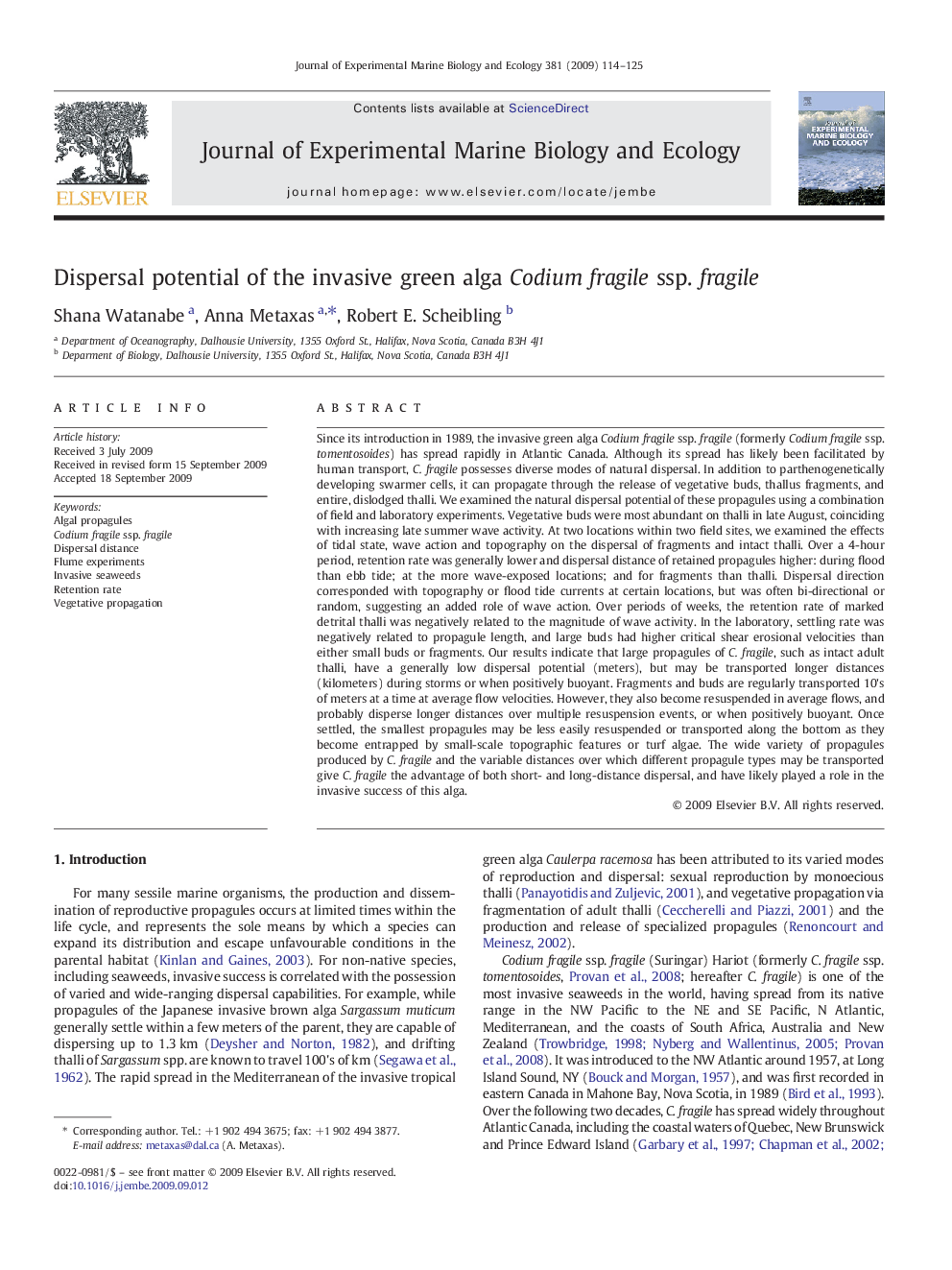| کد مقاله | کد نشریه | سال انتشار | مقاله انگلیسی | نسخه تمام متن |
|---|---|---|---|---|
| 4396831 | 1305845 | 2009 | 12 صفحه PDF | دانلود رایگان |
عنوان انگلیسی مقاله ISI
Dispersal potential of the invasive green alga Codium fragile ssp. fragile
دانلود مقاله + سفارش ترجمه
دانلود مقاله ISI انگلیسی
رایگان برای ایرانیان
کلمات کلیدی
موضوعات مرتبط
علوم زیستی و بیوفناوری
علوم کشاورزی و بیولوژیک
علوم آبزیان
پیش نمایش صفحه اول مقاله

چکیده انگلیسی
Since its introduction in 1989, the invasive green alga Codium fragile ssp. fragile (formerly Codium fragile ssp. tomentosoides) has spread rapidly in Atlantic Canada. Although its spread has likely been facilitated by human transport, C. fragile possesses diverse modes of natural dispersal. In addition to parthenogenetically developing swarmer cells, it can propagate through the release of vegetative buds, thallus fragments, and entire, dislodged thalli. We examined the natural dispersal potential of these propagules using a combination of field and laboratory experiments. Vegetative buds were most abundant on thalli in late August, coinciding with increasing late summer wave activity. At two locations within two field sites, we examined the effects of tidal state, wave action and topography on the dispersal of fragments and intact thalli. Over a 4-hour period, retention rate was generally lower and dispersal distance of retained propagules higher: during flood than ebb tide; at the more wave-exposed locations; and for fragments than thalli. Dispersal direction corresponded with topography or flood tide currents at certain locations, but was often bi-directional or random, suggesting an added role of wave action. Over periods of weeks, the retention rate of marked detrital thalli was negatively related to the magnitude of wave activity. In the laboratory, settling rate was negatively related to propagule length, and large buds had higher critical shear erosional velocities than either small buds or fragments. Our results indicate that large propagules of C. fragile, such as intact adult thalli, have a generally low dispersal potential (meters), but may be transported longer distances (kilometers) during storms or when positively buoyant. Fragments and buds are regularly transported 10's of meters at a time at average flow velocities. However, they also become resuspended in average flows, and probably disperse longer distances over multiple resuspension events, or when positively buoyant. Once settled, the smallest propagules may be less easily resuspended or transported along the bottom as they become entrapped by small-scale topographic features or turf algae. The wide variety of propagules produced by C. fragile and the variable distances over which different propagule types may be transported give C. fragile the advantage of both short- and long-distance dispersal, and have likely played a role in the invasive success of this alga.
ناشر
Database: Elsevier - ScienceDirect (ساینس دایرکت)
Journal: Journal of Experimental Marine Biology and Ecology - Volume 381, Issue 2, 15 December 2009, Pages 114-125
Journal: Journal of Experimental Marine Biology and Ecology - Volume 381, Issue 2, 15 December 2009, Pages 114-125
نویسندگان
Shana Watanabe, Anna Metaxas, Robert E. Scheibling,